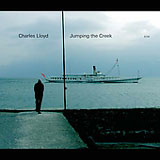Home » Jazz Articles » Album Review » Charles Lloyd: Jumping the Creek
Charles Lloyd: Jumping the Creek
That's not to say that Lloyd's penchant for writing or finding lyrical material has gone by the wayside. But when Lloyd and his current quartet—featuring pianist Geri Allen, bassist Robert Hurst, and drummer Eric Harland—tackle even the most bittersweet romantic material, like the opening Jacques Brel piece "Ne Me Quitte Pas, it's clear that they are approaching it from a more liberated place. And while the quartet comes more directly from the American jazz tradition, there are also distinct notions of the more European impressionism of Lloyd's '90s groups. The result is something of a consolidation and, as Stanley Crouch describes in the liner notes, summation of Lloyd's forty-year musical and spiritual quest.
While Lloyd exploits the inestimable talent and power of the quartet, he also breaks it down into a mix of duo and trio pieces. "Ken Katta Ma Om starts as a loosely-formed duet between Lloyd and Harland—an intuitive drummer who, since emerging on the scene in the mid-'90s, has been garnering a growing reputation with artists including McCoy Tyner and Terence Blanchard—but resolves into a three-way conversation when Allen joins in. Allen, whose recent release The Life of a Song shows just how much she has grown as a player in the past few years, demonstrates the ability to wear many hats—from richly melodic and on form to abstract and unfettered. The title track is a largely free exchange that finds the group exploring the various permutations and combinations possible, all within a brief six-minute span.
Hurst, a bassist who emerged in the mainstream with Wynton Marsalis in the '80s, has broadened his reach in recent years with artists as diverse as Lou Rawls, Keb' Mo' and Terri Lyne Carrington. On Jumping the Creek he is equally stylistically unencumbered, as comfortable on the Eastern-tinged "The Sufi's Tears as he is the more swinging, yet still open-ended "Sweet Georgia Bright, which makes up the second half of the "Georgia Bright Suite.
Lloyd's voice has never been better. While sometimes dismissed as a Coltrane knockoff, such direct comparisons miss the point. Truthfully, Lloyd is the sum total of a wider range of musical references that go much farther back. Still, his supple approach and robust tone are instantly recognizable, taking his influences to a more modern musical space; and Jumping the Creek represents a clear highlight in a career filled with memorable milestones.
Visit Charles Lloyd and Universal Classics on the web.
Track Listing
Ne Me Quitte Pas; Ken Matta Ma Om (Bright Sun Upon You); Angel Oak Revisited; Canon Perdido; Jumping the Creek; The Sufi's Tears; Georgia Bright Suite: a. Pythagoras at Jeckyll Island, b. Sweet Georgia Bright; Come Sunday; Both Veils Must Go; Song of the Inuit
Personnel
Charles Lloyd
saxophoneCharles Lloyd- tenor and alto saxophones, taragato; Geri Allen- piano; Robert Hurst- double-bass, Eric Harland- Drums, Percussion
Album information
Title: Jumping The Creek | Year Released: 2005 | Record Label: ECM Records
< Previous
Jazz Age Songs: 372 Free Recordings f...
Next >
85 Candles: Live in New York
Comments
About Charles Lloyd
Instrument: Saxophone
Related Articles | Concerts | Albums | Photos | Similar ToTags
For the Love of Jazz
 All About Jazz has been a pillar of jazz since 1995, championing it as an art form and, more importantly, supporting the musicians who create it. Our enduring commitment has made "AAJ" one of the most culturally important websites of its kind, read by hundreds of thousands of fans, musicians and industry figures every month.
All About Jazz has been a pillar of jazz since 1995, championing it as an art form and, more importantly, supporting the musicians who create it. Our enduring commitment has made "AAJ" one of the most culturally important websites of its kind, read by hundreds of thousands of fans, musicians and industry figures every month.




















